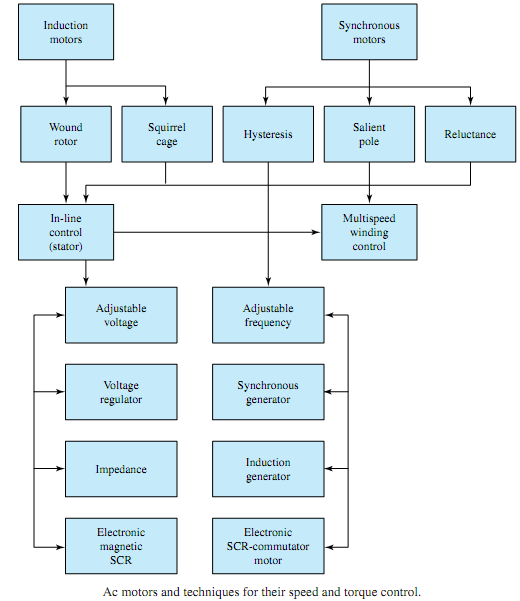Starting Methods for Polyphase Induction Motors
When high starting torques are required, a wound-rotor induction motor, with external resistances inserted in its rotor circuits, can be used. The starting current can be reduced and high values of starting torque per ampere of starting current can be obtained with rotor-resistance starting. The external resistances are generally cut out in steps as the machine runs up to speed.
For squirrel-cage-rotor machines, the problem is to keep down the starting current while maintaining adequate starting torque. The input current, for example, can be no more than 6 times the full-load current,while the starting torquemay be about 1.5 times the full-load torque.Depending on the capacity of the available supply system, direct-on-line starting may be suitable only for relatively small machines, up to 10-hp rating. Other starting methods include reduced-voltage starting by means of wye-delta starting, autotransformer starting, or stator-impedance starting.

For employing the wye-delta starting method, a machine designed for delta operation is connected in wye during the starting period. Because the impedance between line terminals for wye connection is three times that for delta connection for the same line voltage, the line current at standstill for wye connection is reduced to one-third of the value for delta connection. Since the phase voltage is reduced by a factor of √3 during starting, it follows that the starting torque will be one-third of normal. For autotransformer starting, the setting of the autotransformer can be predetermined to limit the starting current to any desired value.An autotransformer,which reduces the voltage applied to the motor to x times the normal voltage, will reduce the starting current in the supply system as well as the starting torque of the motor to x2 times the normal values.
Stator-impedance starting may be employed if the starting-torque requirement is not severe. Series resistances (or impedances) are inserted in the lines to limit the starting current. These resistances are short-circuited out when the motor gains speed. This method has the obvious disadvantage of inefficiency caused by the extra losses in the external resistances.